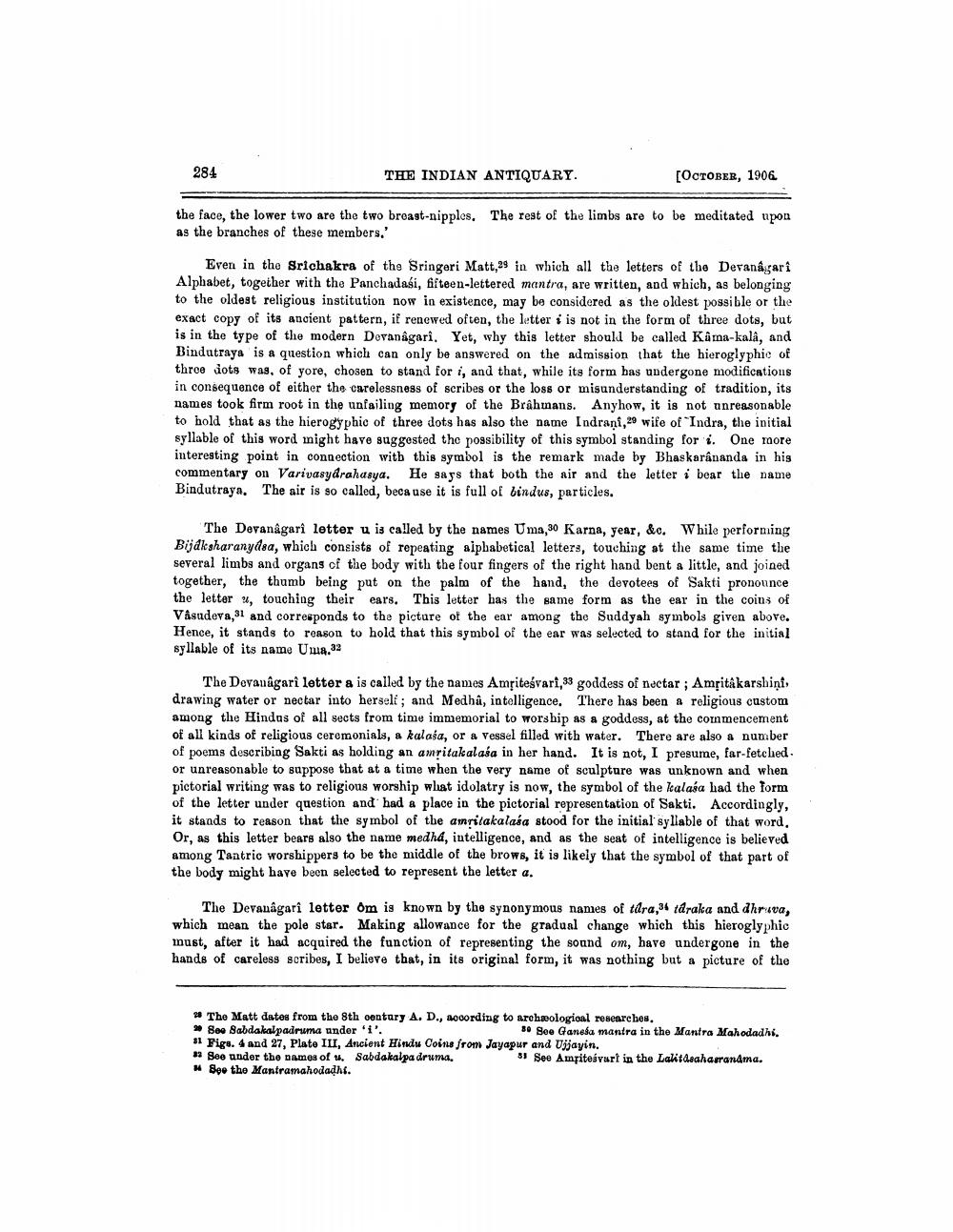________________
284
THE INDIAN ANTIQUARY.
[OCTOBER, 1906
the face, the lower two are the two breast-nipples. The rest of the limbs are to be meditated upon as the branches of these members,
Even in the Srichakra of the Sringeri Matt.29 in which all the letters of the Devanagari Alphabet, together with the Panchadasi, fifteen-lettered mantra, are written, and which, as belonging to the oldest religious institution now in existence, may be considered as the oldest possible or the exact copy of its ancient pattern, if renewed often, the letter i is not in the form of three dots, but is in the type of the modern Dovanagari. Yet, why this letter should be called Kama-kalâ, and Bindutraya is a question which can only be angwered on the admission that the hieroglyphic of throe dots was, of yore, chosen to stand for i, and that, while its form bas undergone modifications in consequence of either the carelessness of scribes or the loss or misunderstanding of tradition, its names took firm root in the unfailing memory of the Brahmans. Anyhow, it is not unreasonable to hold that as the hierogyphic of three dots has also the name Indrani,20 wife of "Indra, the initial syllable of this word might have suggested the possibility of this symbol standing for i. One more interesting point in connection with this symbol is the remark made by Bhaskarananda in his commentary on Varivasydrahasya. He says that both the air and the letter i bear the name Bindutraya. The air is so called, because it is full of bindus, particles.
The Devanagari letter u is called by the names Uma 30 Karna, year, &c. While performing Bijdksharanydea, which consists of repeating alphabetical letters, touching at the same time the several limbs and organs of the body with the four fingers of the right hand bent a little, and joined together, the thumb being put on the palm of the hand, the devotees of Sakti pronounce the letter ?, touching their ears. This letter has the same form as the ear in the coins of Vasudeva, 31 and corresponds to the picture of the ear among the Suddyah symbols given above. Hence, it stands to reason to hold that this symbol of the ear was selected to stand for the initial syllable of its name Uma 32
The Devanagari letter a is called by the names Ampiteśvari,33 goddess of nectar; Ampita karshiņi, drawing water or nectar into herself; and Medhû, intelligence. There has been a religious custom among the Hindas of all sects from time immemorial to worship as a goddess, at the commencement of all kinds of religious ceremonials, a kalasa, or a vessel filled with water. There are also a number of poems describing Sakti as holding an amritakalasa in her hand. It is not, I presume, far-fetched. or unreasonable to suppose that at a time when the very name of sculpture was unknown and when pictorial writing was to religious worship wliat idolatry is now, the symbol of the kalasa had the form of the letter under question and had a place in the pictorial representation of Sakti. Accordingly, it stands to reason that the symbol of the amritakalasa stood for the initial syllable of that word, Or, as this letter bears also the name medha, intelligence, and as the seat of intelligence is believed among Tantric worshippers to be the middle of the brows, it is likely that the symbol of that part of the body might have been selected to represent the letter a.
The Devanagari letter om is known by the synonymous names of tdra,34 tdraka and dhruva, which mean the pole star. Making allowance for the gradual change which this hieroglyphic must, after it had acquired the function of representing the sound om, have undergone in the hands of careless scribes, I believe that, in its original form, it was nothing but a picture of the
# The Matt dates from the 8th century A. D., according to archeological researches. » Se Sabdakalpadruma under 'i'.
39 Soo Ganesa mantra in the Mantra Mahodadhi. 31 Pige. 4 and 27, Plato III, Ancient Hindu Coins from Jayapur and Ujjayin. » Soe under the names of 14. Sabdakalpa druma.
31 See Amfiteávart in the Lalitheaharanama. M 8oo the Mantramahodadh.




